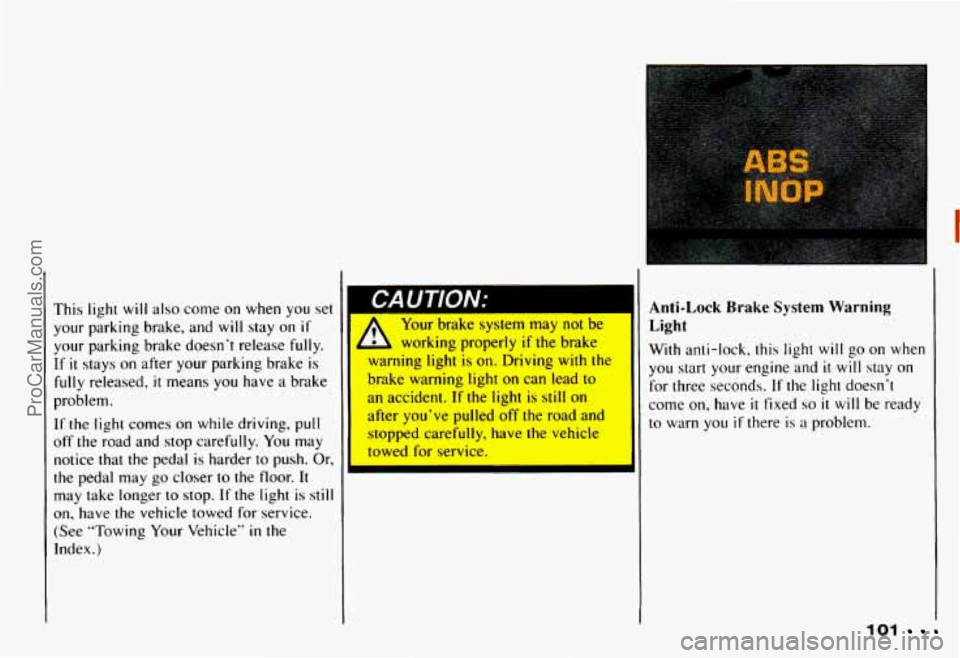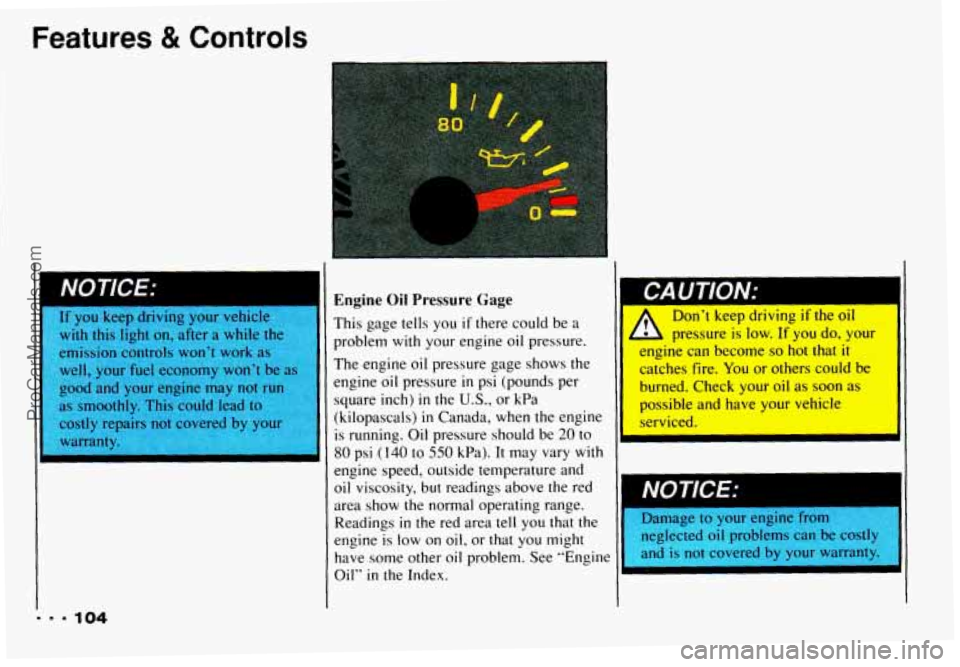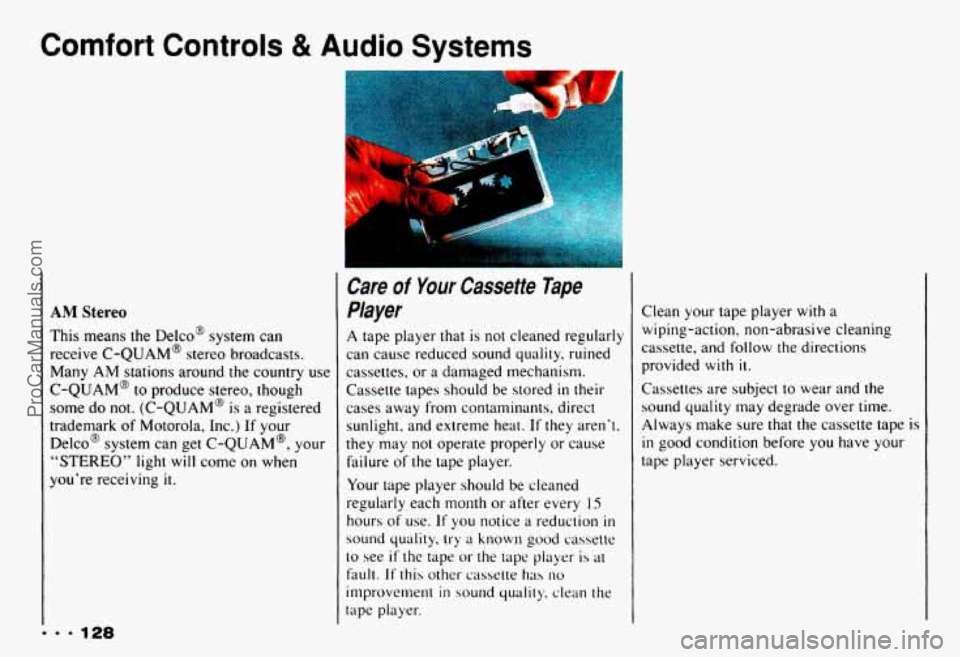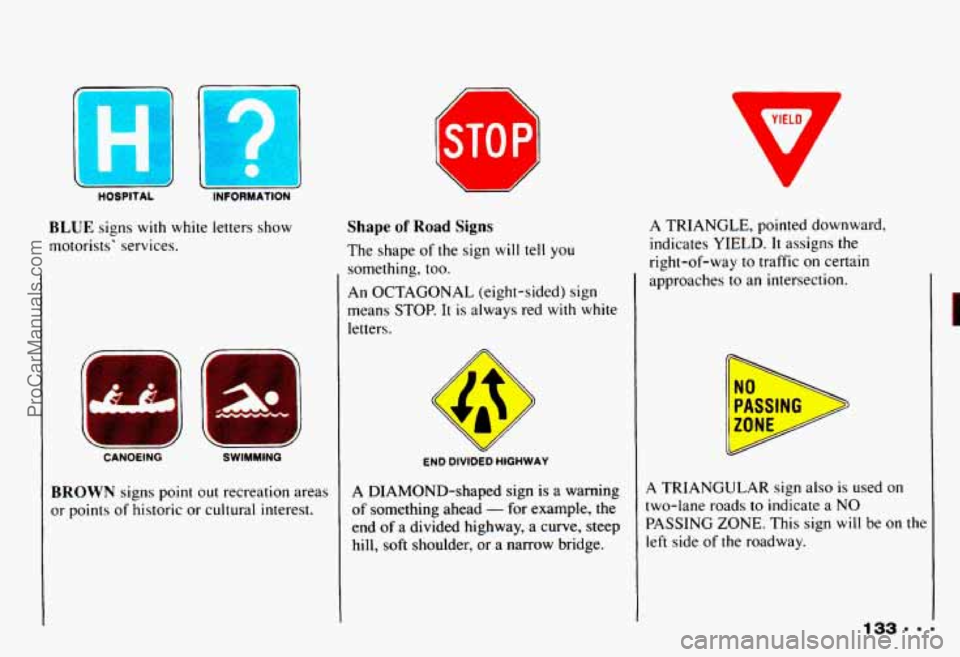1993 CHEVROLET CAMARO service
[x] Cancel search: servicePage 105 of 358

I
This light will also come on when you set
your parking brake, and will stay on
if
your parking brake doesn’t release fully.
If it stays on after your parking brake is
fully released, it means you have a brake
problem.
If the light comes on while driving, pull
off the road and stop carefully. You may
notice that the pedal is harder to push. Or,
the pedal may
go closer to the floor. It
may take longer to stop.
If the light is still
on, have the vehicle towed for service.
(See “Towing Your Vehicle”
in the
Index.)
I
CAUTION: II ____~
Your brake system may not be
working properly if the brake
warning light is on. Driving
with the
brake warning light on can lead to
an accident. If the light is still
on
after you’ve pulled off the road and
stopped carefully, have the vehicle
towed for service.
I
Anti-Lock Brake System Warning
Light
With anti-lock, this light will go on when
you start your engine and
it will stay on
for three seconds.
If the light doesn‘t
come
on, have it fixed so it will be ready
to warn
you if there is a problem.
101
ProCarManuals.com
Page 106 of 358

Features 8t Controls
f
I
I
. ’ 102
If the light stays on or comes on when
you’re driving, stop
as soon as possible
and turn the key off. Then start the engine
to reset the system. If the light still stays
on, or comes on again while you’re
driving, your Chevrolet needs service.
Unless the regular brake system warning
light is also on, you
will still have brakes,
but not anti-lock brakes. If the regular
brake system warning
light is also on, see
“Brake System Warning Light” earlier
in
this part. When your anti-lock system is working,
the message
LOW TRAC will appear on
your instrument cluster. This means that
slippery road conditions may exist. Adjust
your driving accordingly. The light
will
stay on for about four seconds after the
ABS stops working. The
LOW TRAC
light also comes on during engine starting
as
a bulb check.
Engine Coolant Temperature Gage
This gage shows the engine coolant
temperature.
If the gage pointer moves
into the red area, your engine is
too hot!
It means that your engine coolant has
overheated. If you have been operating
your vehicle under normal driving
conditions, you should
pull off the road,
stop your vehicle and
turn off the engine
as soon as possible.
HOT COOLANT CAN BURN YOU
BADLY!
In ”Problerns on the Road,” this manual
shows
what to do. See “Engine
Overheating”
in the Index.
ProCarManuals.com
Page 107 of 358

Voltmeter
You can read battery voltage on your
voltmeter. If
it reads less than 1 I volts or
more than
16 volts while your engine is
running, and
it stays there, you may have
a problem with the electrical charging
system. Have
it checked right away.
Driving with the voltmeter reading
in a
warning zone could drain your battery.
If you idle your engine for a while, the
voltmeter reading might move into the
yellow zone.
If the reading stays in the
yellow zone while you are driving, you
may have a problem with
the electrical
charging system. Have
it checked. While
the voltmeter reads
in the yellow zone,
your battery may
not be able to power
certain electrical accessories, like ABS.
(If this happens, your ABS INOP light
will come
on, See "Anti-Lock Brake
System Warning Light"
in this part.)
It' you must drive a short distance with the
voltmeter reading
in a warning zone. turn
off all your accessories, including your
comfort control and audio systems.
Malfunction Ind-kator Lamp
(Service Engine Soon Light)
A computer monitors operation of your
fuel, ignition and emission control
systems. This light should come on when
the ignition is
on, but the engine is not
running, as a check
to show you il is
working.
If it does not come on at all,
have
it fixed right away. If it stays on, or
it comes on while you are driving, the
computer is indicating that you have
a
problem. You should take your vehicle in
for service soon.
ProCarManuals.com
Page 108 of 358

Features & Controls
It you keep driving your vehicle
with this
fight on, after a while
emission controls won’t work
well, your fuel economy won’t be
good and your engine may
not rul
as smoothly. This could lead tc
costly repairs not covered by y
warranty.
... 104
Engine Oil Pressure Gage
This gage tells you if there could be a
problem with your engine oil pressure.
The engine oil pressure gage shows the
engine oil pressure
in psi (pounds per
square inch)
in the U.S., or kPa
(kilopascals)
in Canada, when the engine
is running. Oil pressure should be 20 to
80 psi (140 to 550 kPa). It may vary with
engine speed, outside temperature and
oil viscosity, but readings above the red
area show the normal operating range.
Readings
in the red area tell you that the
engine is
low on oil, or that you might
have some other oil problem. See “Engine
Oil”
in the Index.
Don’t keep driving if the oil
h pressure is low. If you do, your
cllgine can become
so hot that it
I catches fire. You or others could be
burned. Check your
oil as soon as
possible and have your vehicle
serviced.
I NOTICE:
‘I
3
Damage your engine from
neglected oil problems can be costl)
ProCarManuals.com
Page 132 of 358

Comfort Controls & Audio Systems
AM Stereo
This means the Delco@ system can
receive C-QUAM@ stereo broadcasts.
Many AM stations around the country use
C-QUAM@
to produce stereo, though
some
do not. (C-QUAM@ is a registered
trademark
of Motorola, Inc.) If your
Delco@ system can get C-QUAM@, your
“STEREO” light will come on when
you’re receiving
it.
I
Care of Your Cassette Tape
Player
A tape player that is not cleaned regularly
can cause reduced sound quality, ruined
cassettes, or a damaged mechanism.
Cassette tapes should be stored
in their
cases away from contaminants, direct
sunlight, and extreme heat. If they aren’t.
they may not operate properly or cause
failure
of the tape player.
Your tape player should be cleaned
regularly each month or after every
IS
hours of use. If you notice a reduction in
sound quality. try a known good cassette
to see
if the tape or the tape player is a1
fault. If this other cassette has no
improvenlent in sound qualily. clean the
tape player. Clean
your tape player
with a
wiping-action, non-abrasive cleaning
cassette, and follow the directions
provided with it.
Cassettes are subject to wear and the
sound quality may degrade over time.
Always make sure that the cassette tape is
in good condition before you have your
tape player serviced.
ProCarManuals.com
Page 137 of 358

V
YIELD
ST0 PI1
E
HOS
Shape of Road Signs
The shape of the sign will tell you
something,
too.
An OCTAGONAL (eight-sided) sign
means STOP.
It is always red with white
letters.
A TRIANGLE, pointed downward,
indicates YIELD.
It assigns the
right-of-way
to traffic on certain
approaches
to an intersection.
BLUE signs with white letters show
motorists’ services.
I
v CANOEING END DIVIDED HIGHWAY
A TRIANGULAR sign also is used on
two-lane roads to indicate a NO
PASSING ZONE. This sign
will be on the
left side
of the roadway.
BROWN signs point out recreation areas
or points of historic or cultural interest. A
DIAMOND-shaped sign is a warning
of something ahead - for example, the
end
of a divided highway, a curve, steep
hill,
soft shoulder, or a narrow bridge.
ProCarManuals.com
Page 149 of 358

Disc Brake Wear Indicators
Unless you have the four-wheel disc
brake option, your Chevrolet has front
disc brakes and rear drum brakes.
Disc brake pads have built-in wear
indicators that make a high-pitched
warning sound when the brake pads are
worn and new pads are needed. The
sound may come and go or be heard all
the time your vehicle is moving (except
when you are pushing on the brake peda
firmly). 1 The brake wear warning sound
- means that sooner or later your
brakes won’t work well. That could
lead to an accident. When you hear
the brake wear warning sound, have
your vehicle serviced.
I
I
.1 LullllllullIg 1u UIIVt: Wllll WUIII-UU
brake pads could result in rnctl\~
brake repair. Some driving conditions
or climates may
cause a brake squeal when the brakes are
first applied or lightly applied. This does
not mean something
is wrong with your
brakes.
Rear Drum Brakes
If you have rear drum brakes, they don’t
have wear indicators,
but if you ever hear
a rear brake rubbing noise, have the rear
brake linings inspected.
Also, the rear
brake drums should be removed and
inspected each time the tires are removed
for rotation or changing. When you have
the front brakes replaced, have the rear
brakes inspected, too.
Brake linings should always be replaced
as complete axle sets.
ProCarManuals.com
Page 158 of 358

Your Driving and the Road
But if you’re driving, don’t wear
sunglasses at night. They may cut down
on glare from headlights, but they also
make a lot
of things invisible that should
remain visible
- such as parked cars,
obstacles, pedestrians,
or even trains
blocking railway crossings. You may
want to put
on your sunglasses after you
have pulled into a brightly-lighted service
or refreshment area. Eyes shielded from
that glare may adjust more quickly to
darkness back on the road. But be sure to
remove your sunglasses before you leave
the service
area.-^-
You can be temporarily blinded by
approaching lights.
It can take a second or
two, or even several seconds, for your
eyes to readjust to the dark. When you are
faced with severe glare (as from a driver
who doesn’t lower the high beams, or a
vehicle
with misaimed headlights), slow
down a
little. Avoid staring directly into
the approaching lights. If there is a line of
opposing traffic, make occasional glances
over the line
of headlights to make certain
that one
of the vehicles isn’t starting to
move into
your lane. Once you are past
the bright lights, give your eyes time to
readjust before resuming speed.
High Beams
[f the vehicle approaching you has its
high beams on, signal
by flicking yours to
high and then back to low beam. This is
:he usual signal to lower the headlight
beams. If the other driver
still doesn’t
lower the beams, resist the temptation
to
put your high beams on. This only makes
two half-blinded drivers.
On a freeway, use your high beams only
in remote areas where you won’t impair
approaching drivers. In some places, like
Zities, using high beams is illegal.
ProCarManuals.com